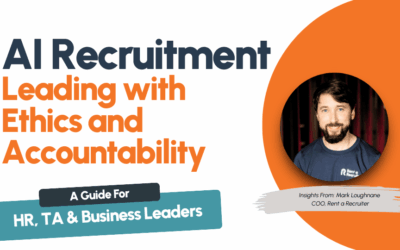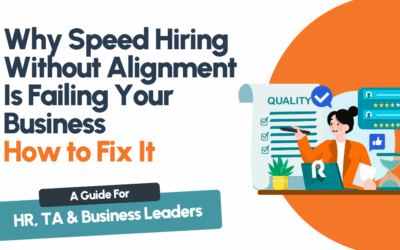Fractional Recruiter & Fractional Recruitment: Agility, Savings & Growth
Thinking about hiring a fractional recruiter but not sure how it works or whether it’s worth it? This blog explains exactly what fractional recruitment is, why it’s growing fast, and how it compares to traditional models. You’ll see real stats, examples, and insights on how fractional hiring can cut costs, improve agility, and help you access top talent faster all without committing to full‑time overheads.
What is Fractional Recruitment?
A fractional recruiter (or fractional recruitment model) means hiring recruiting expertise on a part‑time, project‑based or “as‑needed” basis rather than employing a full‑time recruiter or relying exclusively on external agencies. In this arrangement, the fractional recruiter works closely with the company for a defined few hours, weeks or months, often integrating into your existing HR / Talent Acquisition (TA) team to handle specific hiring tasks or surges.

This model gives businesses flexibility and access to experienced recruiting talent, while avoiding full‑salary overhead, long hiring lead times, or the high fees of traditional placement agencies.
Why Fractional Recruitment is Increasing in Popularity
As companies seek more agile and cost-effective hiring models, fractional recruitment is rapidly gaining traction. The data below highlights the accelerating adoption of fractional roles especially at senior levels and the growing demand for flexible talent strategies.
| Statistic | Description / Implication |
|---|---|
| 57% increase in fractional jobs since 2020 | According to Slone Partners, fractional executive roles (part-time or project-based) rose 57% from 2020 to 2022. |
| +18% from 2021 to 2022 | Fractional jobs rose by approximately 18% in just one year, highlighting rapid adoption. |
| Use of fractional hiring by businesses | In the U.S., about 25% of businesses use fractional hiring; projected to hit 35% by 2025. In Europe, it’s currently 20%, projected to reach 30%. |
| Tripling of executive job postings with fractional options since 2018 | Revelio Labs reports that job postings for executive roles mentioning fractional or part-time leadership have tripled since 2018. |
Key Drivers of Fractional Recruitment
- Economic uncertainty & need for agility: Companies want to scale up or down hiring without long‑term fixed commitments. Fractional recruitment allows that flexibility.
- Skills gaps / specialist requirements: Businesses often need specialist recruiting skill (e.g., tech, executive, niche sectors) but not often enough to justify a full‑time head. Fractional recruiters fill these gaps.
- Cost pressures: Full‑time recruiters bring salary + benefits + overheads; agency fees are often high. Fractional models help reduce these costs.
- Remote & hybrid work shift: Post‑COVID, remote and hybrid working has forced companies to rethink how and when roles need to be permanently filled vs temporarily supported. Fractional models often work well in distributed / part‑time settings.

Benefits of Hiring a Fractional Recruiter
Fractional recruiters offer a unique blend of flexibility, cost control, and expertise. Here’s a breakdown of the key advantages this model can bring to your hiring strategy.
| Benefit Area | Details |
|---|---|
| Cost Efficiency |
|
| Flexibility & Scalability |
|
| Specialised Expertise & Faster Ramp-Up |
|
| Lower Risk, Greater Agility |
|
| Higher Strategic Focus |
|
If speed, quality and flexibility are priorities
Our embedded recruiters integrate within 5 days, Contact us to schedule a diagnostic and see how fractional recruitment could work for your hiring roadmap.
Fractional Recruitment vs Other Models
To decide if fractional recruitment is the right fit, it helps to compare it directly with other hiring models. The table below outlines when each model works best, along with their key strengths and trade-offs.
| Model | When Best | Pros | Cons |
|---|---|---|---|
| Full-Time In-House Recruiter | When there is steady, high volume hiring; you want ownership of talent pipeline; long-term culture fit. | Deep knowledge of business, culture; consistency; alignment. | Fixed cost, possibly under-utilised in slow periods; hiring, training time; benefits & overhead. |
| Recruitment Agency | One-off hires; urgent hiring; talent markets where in-house access is weak. | Access to larger candidate pools; fast; low internal workload. | High cost per hire; less control over process; variable quality; sometimes transactional. |
| Fractional / Embedded Recruiter | When hiring needs fluctuate; you need specialist support; budget is constrained; want control but low commitment. | Best of both: quality, cost containment, flexibility; embedded means alignment plus external expertise. | Less availability than full time; shared focus if fractional time is split; onboarding time still needed. |
How to Decide if a Fractional Recruiter is Right for Your Business
Here are key questions / criteria to guide decision‑making. If you can answer yes to many, fractional recruitment is probably a good option.
- Do you have variable hiring demand?
If hiring volume swings significantly (e.g. product launches, seasonal hiring, funding rounds), fractional models give you agility. - Is your hiring pipeline currently overloaded?
If internal TA is stretched, or if the quality of recruitment is slipping due to resource constraints. - Are you struggling with costs / ROI of existing method?
High agency fees, long hiring cycles, high attrition can all point to inefficiencies. - Do you lack specialist recruiting expertise, especially for niche roles or leadership?
- Is your internal HR or TA infrastructure suitable to accommodate part‑time/embedded support?
You’ll need processes, stakeholder alignment, hiring managers’ clarity etc. to make fractional support efficient.
Challenges & How to Mitigate Them
While fractional recruitment offers flexibility and value, it’s not without its challenges. Here are the most common pitfalls and practical steps you can take to avoid them.
While fractional recruitment brings many upsides, there are some potential drawbacks, which you should plan for.
| Challenge | Mitigation / Best Practices |
|---|---|
| Divided attention & availability | Clarify hours, deliverables, priorities; ensure fractional recruiter has enough time allocated; build feedback cadence. |
| Onboarding & alignment | Spend time early to bring them up to speed on culture, systems, employer brand, hiring goals. Possibly have overlap period. |
| Consistency | Embedded fractions perform best when they are consistent over time, even if part-time. Avoid switching frequently. |
| Ownership & accountability | Define KPIs clearly (time-to-fill, quality of hire, candidate experience etc.), governance with hiring managers. |
FAQs
What’s the difference between a fractional recruiter and a contract recruiter?
Fractional recruiters are often more than just temporary contractors; they integrate with your team, often take ownership of parts of your recruitment process, and are engaged over a longer period of sustained part‑time effort. Contract recruiters may work on specific roles only.
How much does a fractional recruiter cost compared to a full‑time recruiter or agency fees?
Our fractional models usually shave off 30‑70% of hiring costs versus full‑time salaries or agency placement fees, because you only pay for what you use.
Can fractional recruiters handle high‑volume hiring?
Yes, you can scale up your resources as you need. For very large, continuous high‑volume hiring, an embedded TA function may scale more cost‑effectively. Talk to us to find the right solution for your business.
How do we ensure quality and alignment when using fractional recruiters?
We set clear KPIs, schedule regular check‑ins to understand your culture and hiring standards.
How Your Organisation Can Leverage Fractional Recruitment
Fractional recruitment offers a balance of cost efficiency, flexibility, and access to specialist talent especially when hiring volumes are variable or organisations need senior or niche roles filled without the overhead of full‑time employees or high agency fees. Embedded recruitment solutions, augmented by fractional recruiters, represent a strong strategy: they provide deep integration, alignment with internal practices, but still the agility and cost‑control of fractional models.
If your organisation is exploring better ways to scale hiring, reduce cost per hire, improve time‑to‑fill, or bring in senior or difficult‑to‑find roles without long‑term commitment, fractional recruitment is very likely to deliver value.

About the Author:
Mark Loughnane has over 15 years of experience in the recruitment industry, specialising in the development and delivery of scalable recruitment services. His career has spanned high-volume ramp-up projects and day-to-day hiring across the Life Sciences and Manufacturing sectors. Today, Mark leads our Rent a Recruiter service while also managing the wider recruitment team, ensuring clients receive both strategic guidance and hands-on delivery.
Ready to future-proof your hiring?
Talk to us today to discover how your business can benefit from flexible, cost‑efficient hiring models.



